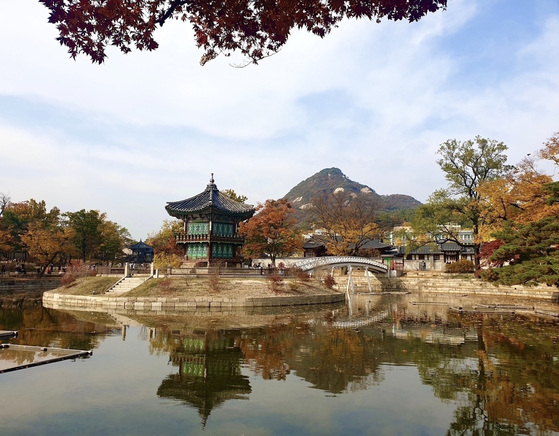Unveiling the timeless beauty of Hyangwonjeong [Photo Essay Contest]

The Korea JoongAng Daily hosted its first photo essay contest for elementary, middle and high school students on the theme: “Promote the beauty of Korea to foreign countries." The contest ran from October to November. Photos containing scenes of traditional culture, family love, places to see and tasty treats in Korea were submitted for the contest.
Won Saemmool from Cornerstone Collegiate Academy of Seoul won the bronze prize in the high school category for this photo essay.
In the enchanting spring of 1887, Korea witnessed a dazzling transformation as it ignited electric lights for the first time. Korea's radiant era unfolded with the flick of a switch, a marvel achieved by drawing water from Hyangwonjeong to power the realm with electricity. The Hyangwonjeong pavilion is a royal pavilion located south of Geonchounggung, a palace inside of Gyeongbokgung Palace. Hyangwonjeong pavilion reflects the culture of Korea, showcasing a blend of nature, architecture, and traditional design.
Around 1873, King Gojong ordered the construction of Hyangwonjeong. King Gojong strategically constructed Geoncheonggung to assert his political autonomy and liberate himself from the influence of his father, Heungseon Daewongun. To establish a distinct political framework, King Gojong orchestrated the development of a pond at the forefront of Geoncheonggung and crafted an artificial island called Hyangwonji. At its center, he built Hyangwonjeong. It was known to be King Gojong's favorite place to stroll with his wife, Empress Myeongseong. It acted as a place of leisure and relaxation for the Joseon Dynasty kings and their family members. King Gojong himself wrote the signboard of Hyangwonjeong.
The name "Hyangwonjeong" translates to "Pavilion of far-reaching fragrance," which evokes the idea of a tranquil space surrounded by the enticing scent of nature. It displays outstandingly beautiful architectural features, including the hexagonal foundation stone and hexagonal hipped roof, and it also shows harmonious proportions and a graceful appearance. These proportions create an exquisite harmony of all the delicate and beautifully refined components. The pavilion floats on the water's surface, surrounding a reflective lotus pond, creating an enchanting ambiance. Hyangwonjeong's design, characterized by graceful curves and intricate detailing, reflects the artistic finesse of traditional Korean craftsmanship. These are why Hyangwonjeong is called an authentic luxury palace that is frugal but not shabby, gorgeous but not extravagant.
Remarkably, Korea's first electric light was produced by drawing water from Hyangwonjeong to supply electricity. Hyangwonjeong's power generation facilities were said to have the best performance out of all the Eastern countries. Korea's first electric lights illuminated the physical landscape and sparked a metaphorical dawn of modernity in the heart of Korea's history. People called the electric lights "water-fire" as it was light made out of water. With the backdrop of the majestic mountains and the palace's historical structures, Hyangwonjeong Pavilion stands as a poetic testament to South Korea's rich cultural heritage. Due to these cultural significances, Hyangwonjeong was designated Korea's no. 1761 national treasure.
In contrast to other pavilions in Korea, Hyangwonjeong stands out for its unique feature called an ondol- a traditional floor heating system under the floor. The purpose of this system was to enable the royal family to comfortably stay in the pavilion even during the chilly winter months. Unlike the conventional ondol structure that generally heats the entire room by placing several rows, the Hyangwonjeong ondol structure selectively provides heating along the room's edges, the smoke traveling along the sides of the first floor, not the middle.
Koreans are putting a lot of effort into restoring and preserving this cultural gem after the Japanese occupation, which damaged the Gyeongbokgung Palace. Today, Hyangwonjeong Pavilion stands as a beautifully restored testament to Korea's architectural heritage, offering visitors a glimpse into the nation's rich history and the enduring beauty of its traditional structures.
By Won Saemmool, Cornerstone Collegiate Academy of Seoul










with the Korea JoongAng Daily
To write comments, please log in to one of the accounts.
Standards Board Policy (0/250자)